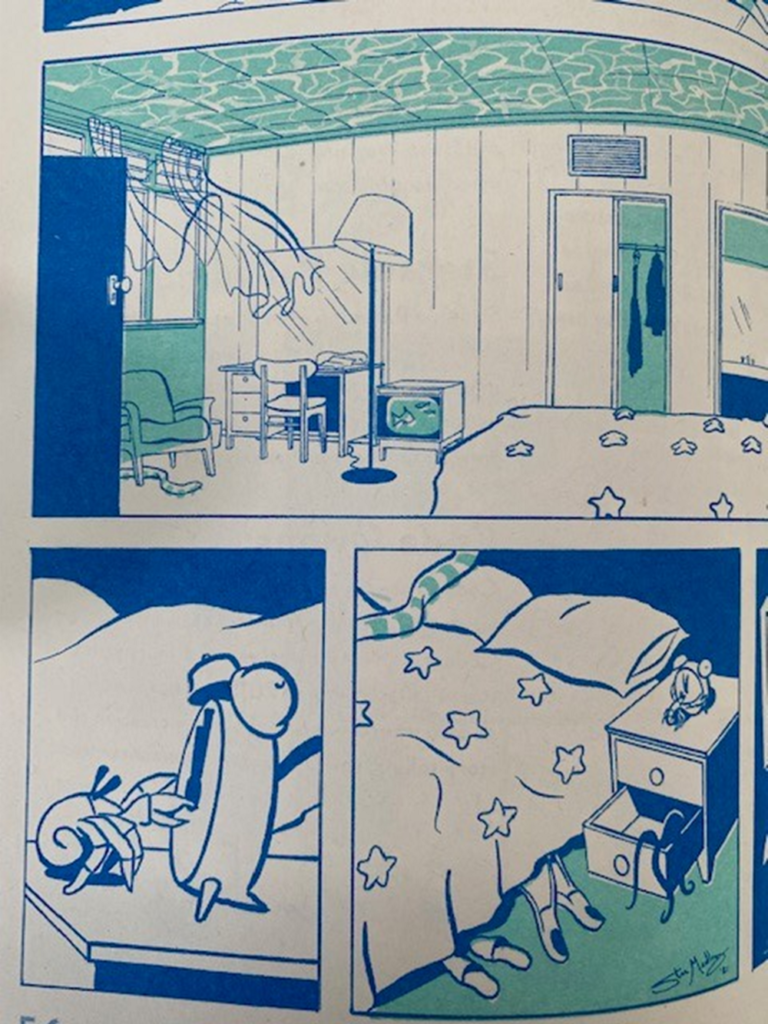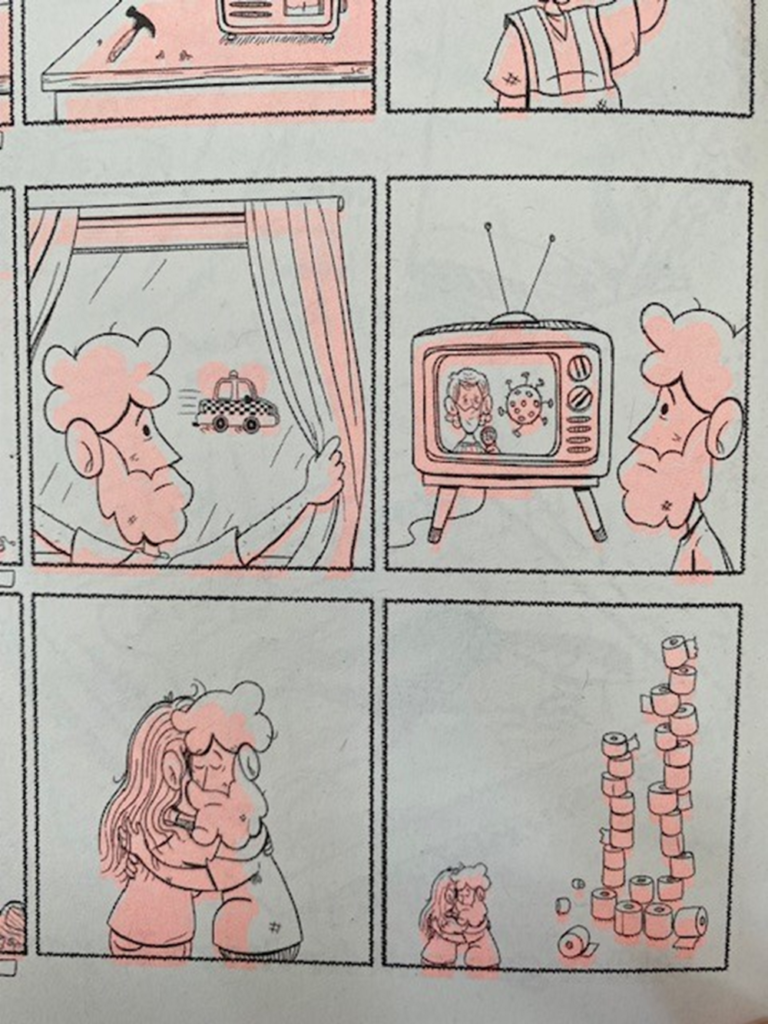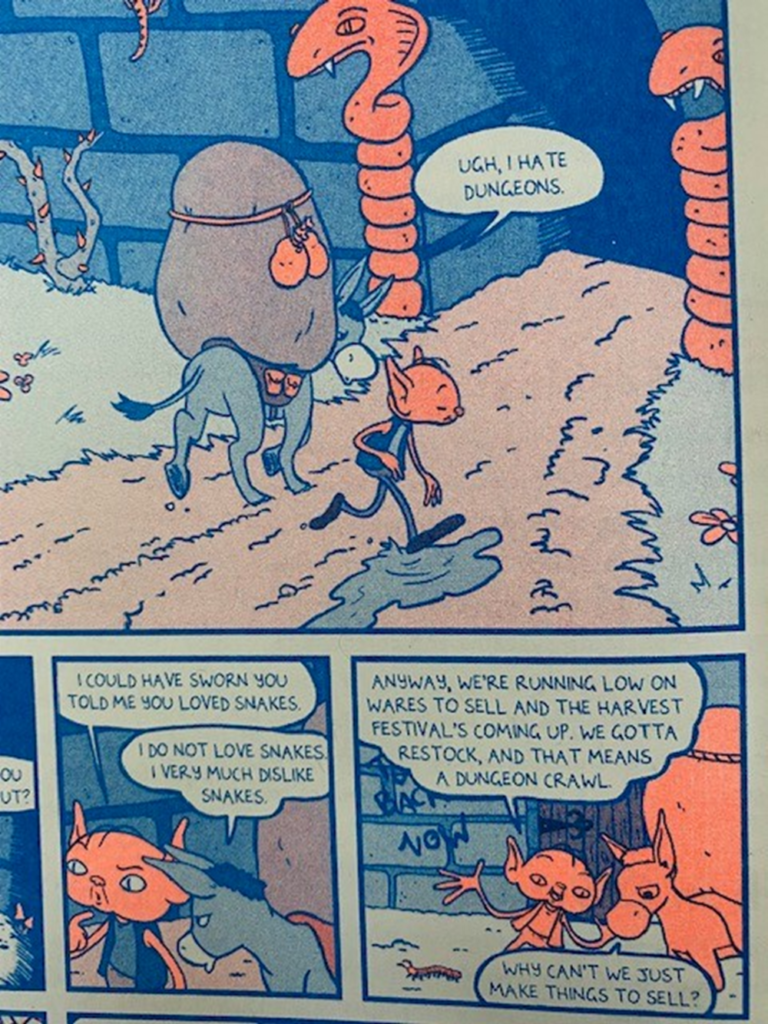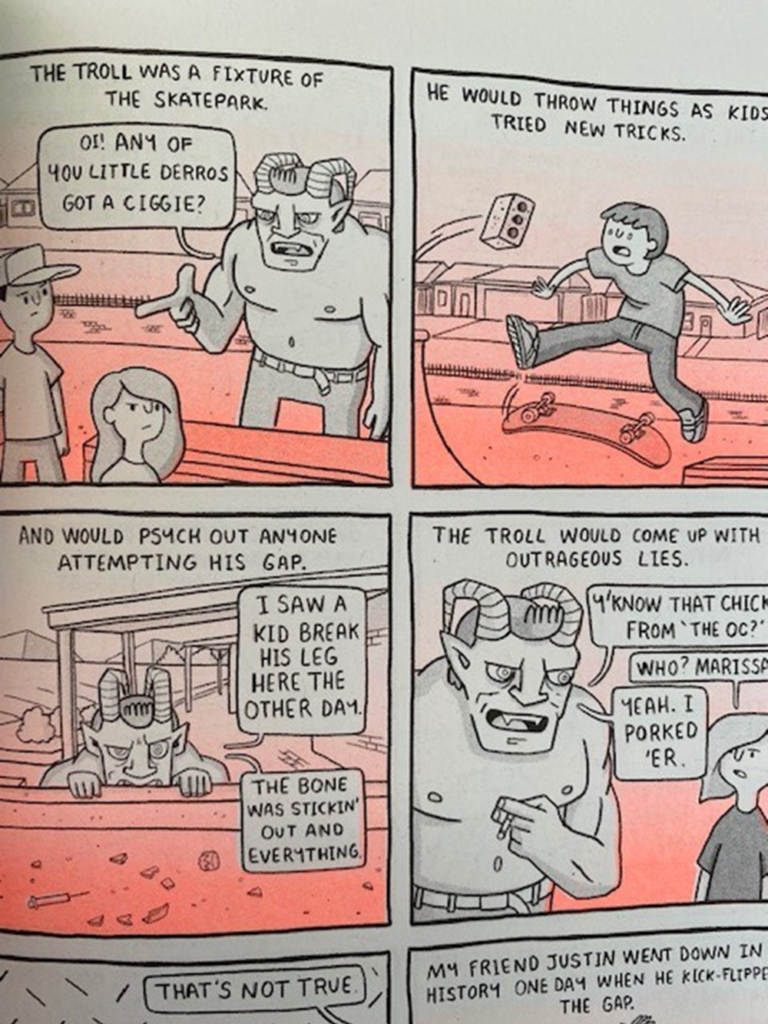Creators: Gavin Aung Than, Campbell Whyte, Tim McEwen, Bruce Mutard, Tim Meakins, Kyle Hughes-Odgers, Brenton McKenna, Edward J. Grug III, Jessica McLeod, Bernard Caleo, Stuart Medley, Mike Greaney, Stacy Gougoulis, Leonie Brialey, Jessica Robley, Aska Illustration, Amy Ge, Nathan Vass Viney, Lola Baldsing, Nina Dakin, Sarah Winifred Searle, Andrei Buters, Tyson Elmer, Alyce Sarich, Annie Huang, Elton D’Souza, Stefanie Palladino, Ellen Broadhurst, Coda Owens, Adam Yusoff, Oscar McKay, Natasha Provan, Alicia Rutigliano, Kikitsa Draws, Blair Caulfield, Scott Alexander and James Knight.
Neighbourhood Press, 2021
Risograph prints are startling to read. Very far removed from standard contemporary colourisation techniques, Risograph is positively lurid. This title, West Coast Comics Anthology, consists of eye-popping colour. “Each 96 page book is 185mm x 260mm and is printed on uncoated FSC® certified paper,” says publisher Neighbourhood Press’ website, “using plant-based Risograph inks in black, blue, mint and fluorescent orange. ” Risograph is old school 1980s technology, rendered obsolete by modern colour printers. It looks literally and figuratively brilliant.

As ably demonstrated by this extract, above, from Bruce Mutard’s work, this colouring technique leads to a sense of exaggerated surrealism in respect of each of the individual stories – here, no less than 36 of them, ranging from a single page to no more than three pages.
The promotional copy to this title explains the regional character of the content and creators:
Western Australia is home to some of Australia’s best comic and graphic artists, who work to create stories that captivate and inspire.
For the first time ever, Neighbourhood Press has collected the work of thirty-six artists who were asked to create short comics or artworks to the theme of PLACE; including references to culture, society, geography and ecology. Artists involved in this anthology either live in Western Australia or have worked to foster a comic community here or within Australia more broadly.
We do not have the spare four hours or so to critique all of the content. And so we will instead focus on some of the stand-out stories in the anthology. Being spoilt for choice, we begin with Blair Caulfield’s Vox Pops. This story is set in Perth. As noted by the publisher, the creators of the anthology all hail from or have an attachment to the city of Perth, “the far-left freckle of nowhere” as local and acclaimed writer Tim Winton once put it, and it is regaled by its inhabitants as the most isolated city on the planet. Perth’s economy is for the most part built upon digging iron ore out of the ground and shipping it off to China, Japan or Korea. It is easy money for investors and is a well-understood business model. As a consequence, in Perth, the creative arts do not receive the fanfare we see in places like Seattle or Austin, let alone London or New York. In respect of comics, Perth is very far removed from Angoulême. To survive in such barren conditions, the creative output must be hardy and persistent. Vox Pops, then, is a small but bright desert flower. Mr Caulfield’s self-deprecating navel-gazing by the various characters is all too familiar to Perthlings. “Finally something interesting is happening in Dullsville, LOL,” says one passer-by. The art drifts from what should be familiar sketches of Forest Place, the Perth Bell Tower, Hay Street Mall, Barrack Street, St George’s Terrace, and finally, Yagan Square for the revelation. The otherwise familiar city landscape is rendered strange and alien by the Risograph colours.
Kikitsa Draws’ comedic horror about a book shop worker named Gloomy is unrelated to Perth, but as it plays out, it suddenly corkscrews, twice, within the space of a mere three pages. We see startling, funny, horrible plot spiral out from mundane beginnings, and which caused your critic to blink and immediately re-read the story. Unlike the majority of the stories contained in the anthology, Gloomy’s tale is not painted in eye-popping colours. Gloomy is, well, gloomy.

Stuart Medley’s two page vignette is a new genre of itself: “Disney apocalyptic”, a tripped-out urban scene but somehow set deep underwater. A pitch black octopus pushes a shopping trolley and a hermit crab occupies an alarm clock as a shell. Mr Medley has adopted Carl Barks’ rounded cartoon style, and this conveys the goofy visual humour of a King Features publication. The water above is apparent from a surface shimmer and the aquatic colours. The architecture is futurist 1950s. But there is no future here. Our interpretation of this dialogue-free story is that this that the sea has dramatically risen as a consequence of global warming, and in the absence of humans, human customs improbably continue on.

Nathan Vass Viney provides us with a tale called “it was different for him“, visiting a theme we have seen often recently: how to cope when trapped in a pandemic lockdown. Each row of panels is accompanied by a “mental health bar” / gauge, graphically describing the fear and frustration of people in isolation. But, as we saw in Emma Évans Virtually the Same https://worldcomicbookreview.com/2021/09/24/virtually-the-same-a-lockdown-corona-diary-review/, the results of behaviours like hoarding toilet paper and cutting one’s own hair can be unexpectedly uplifting:

Briefly back to Perth, Aska’s Welcome to Bayswater gives us an insight into what it is like to live in a rapidly expanding city (fuelled by the previously mentioned commodities boom) where peace is shattered by progress. The sound effects are rendered in Dr Seuss-strength force, and the last panel is a marvel of dynamic emotion:

Jessica Mcleod’s and Edward J. Grug III’s charming Dungeon Crawl comes with the whimsical and charming adventure of Jeff Smith’s Bone or Pug Grumble’s Fairlaine (see https://worldcomicbookreview.com/2019/01/09/fairlaine-the-goblin-in-the-winglands-vol-6-and-fairlaine-the-goblin-the-final-land-vol-7/):

By far and away the funniest and most entertaining of all of the stories in this collection is Mike Greaney’s title-free depiction of a skate park troll. This story resonates with any kid who has hung out in a public area and had to put up with jibes and jeers from older kids with too much time on their hands. This troll is a literal troll, horned and fanged, and with a stinky attitude. He lives in a gap, a ledge in a carpark, rather than under a bridge, along with “broken glass and used syringes.” The troll is immediately unlikeable, an outrageous liar, and menacing, but while he is stupidly reckless, he is not quite dangerous. The kids do not like him, yet neither are they particularly afraid of him. This characterisation of an antagonist who is funny and slightly pathetic is executed by Mr Greaney with masterful brevity.

The title was available from Neighbourhood Press’ website https://www.neighbourhoodpress.net/, but, sadly, we may have bought the last copy. Hopefully this very entertaining compilation is reprinted.
[Editor”s note: With thanks to Wolf Bylsma of Gestalt Comics for drawing our attention to this anthology.]

